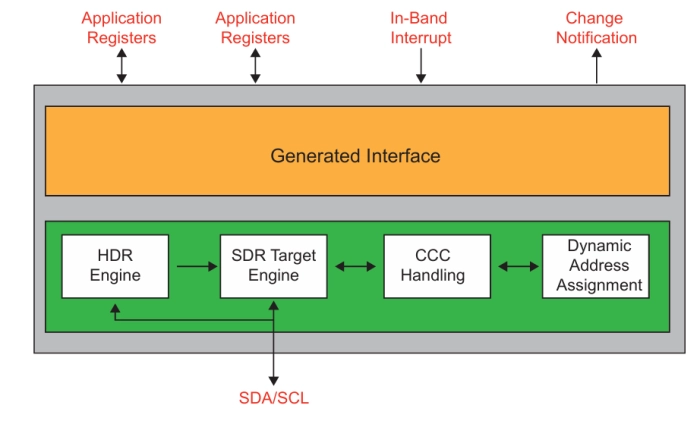The I3C Autonomous Target is intended for simple, data acquisition types of applications where a microprocessor is not needed to process the data. Instead, data is exchanged via a simple set of register interfaces to the application and the controller autonomously manages all of the communication to an upstream I3C Controller.
I3C V1.1 Autonomous Target
Overview
Key Features
- Highly configurable core that allows customer to minimize unneeded logic
- Compliant with MIPI I3C V1.1.1
- Compliant with MIPI I3C Basic V1.1.1
- Dynamic addressing
- Single Data Rate (SDR)
- Error detection types (TE0-TE5)
- Advanced I3C features
- Hot join
- In-band interrupts
- Timing Control
- Asynchronous Mode 0
- Synchronous Mode
- High-speed mode (HDR-DDR)
- Group addressing
- Target reset
- All Common Command Codes (CCCs) supported
- Static I2C address support
- Legacy I2C coexistence, including I2C messaging
- Support for I2C pads with 50ns glitch filter
Block Diagram

Applications
- IoT Edge Devices
- Industrial Sensors
- Small Controllers
- Mixed Signal Digital - MEMS
- Smart Sensors
- Smart Lighting
- Temperature, Pressure, Acceleration Monitors
- Personal Health Monitors
- I3C Connected Devices
Deliverables
- Verilog RTL source code
- Test bench with test suites
- Documentation including User's Guide and Integration Guide
- Technology-independent synthesis constraints
Technical Specifications
Short description
I3C V1.1 Autonomous Target
Vendor
Vendor Name
Related IPs
- I3C V1.1 Advanced Target
- MIPI I3C v1.1.1 Basic Controller and Target
- MIPI I3C v1.1.1 Basic Target lite
- MIPI I3C v1.1.1 Controller and Target
- MIPI I3C Basic v1.1.1 specifications with Host Controller Interface v1.1 specification
- MIPI I3C Master v1.1 Controller IP offers impressive data transmission capacity for sensor integration.